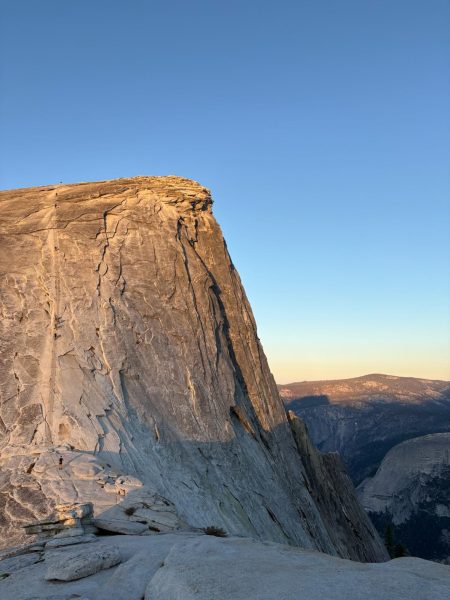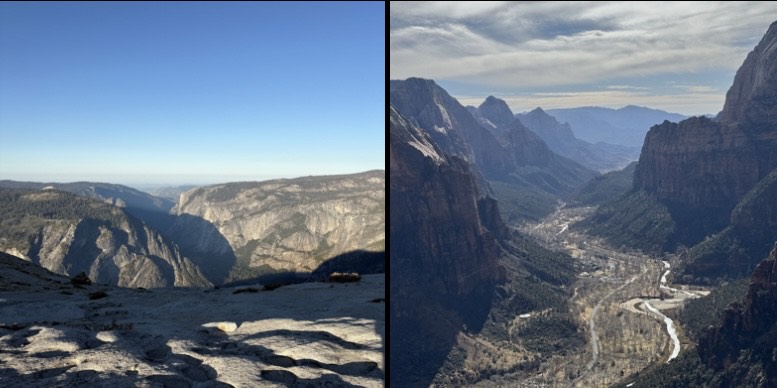For hikers seeking the ultimate challenge, Half Dome in Yosemite National Park and Angels Landing in Zion National Park stand out as two of the most iconic and thrilling trails in the United States. Both are known for their breathtaking views, exposed cliffs and for the physical and mental endurance it takes to complete them. Despite their similarities, they offer different experiences in terms of length, difficulty and risk.
Half Dome, an enormous granite formation in Yosemite National Park, California, is one of the most recognizable landmarks in the country. Rising 8,839 feet above sea level, the summit offers an unparalleled view of Yosemite Valley, the High Sierra and beyond. The hike to Half Dome is no easy feat. The 14 to 16 mile round trip gains nearly 5,000 feet in elevation, requiring strength, stamina and preparation. Most hikers take the Mist Trail or John Muir Trail, which lead past Vernal and Nevada Falls before ascending toward Subdome, a steep, rocky incline that serves as the gateway to the final challenge.
That challenge is what makes Half Dome truly famous: the cables. The last 400 feet of the ascent involves climbing up nearly vertical granite using two steel cables bolted into the rock. Those who reach the summit are rewarded with a once-in-a-lifetime view and a sense of accomplishment. Due to its immense popularity and safety hazards, Half Dome requires a permit, which is distributed through a lottery system. The hike takes anywhere from 10 to 14 hours, making it an all-day adventure.

Angels Landing in Zion National Park, Utah, is a lot of climbing. At around 5.4 miles round trip, this hike is not for the faint of heart. The trail starts innocently at first, along Zion Canyon before climbing to the first challenge, being Walter’s Wiggles, with 21 steep switchbacks leading to Scout Lookout. It is here that most trail hikers take a rest, but for those who press on, the most thrilling section is the final half-mile climb along a slim ridge with 1,000-foot falls off both sides. Hikers must hold onto chains bolted into the rock as they make their way along the thin ledges and slopey inclines.
The exposure isn’t terrible, although one wrong step can kill you. But those who overcome their fears and make it to the summit are treated to a breathtaking view of Zion National Park, one of the most beautiful areas in the U.S. Similar to Half Dome, Angels Landing now has a permit system to manage crowds and enhance safety. The hike is usually 3 to 5 hours, but much more nerve-racking than compared to Yosemite’s endurance test.
Micah Schnaas, a senior at Huntington Beach High School (HBHS), who has hiked both Half Dome and Angels Landing, said, “Both hikes are really cool since the views are really sick, especially when you get to the very top. Half Dome is way harder in my opinion, since it’s a lot longer, but Angel’s Landing is pretty tough too.”

Evan Pham, another senior at HBHS, said, “I honestly like Angels Landing better than Half Dome since when I hiked Half Dome, it took forever and I was genuinely so tired of it. And… Angels Landing is way easier and has better views, so I personally recommend doing Angels Landing more.”
The greatest distinction between these two hikes is their challenge type. Half Dome is a hike based on endurance, and it’s extremely long with hours of walking before hikers even reach the cables. It’s a test of stamina that pays off for those who have the strength to fight off their fatigue. Angels Landing is short but intense, throwing hikers into insane exposure within minutes. While Angels Landing’s chains and thin ridges are intimidating, they are safer than Half Dome’s cables, on which your life depends. Both hikes are different from one another, but they still share some significant similarities.
These two hikes are considered some of America’s most famous and dangerous, requiring careful planning and an appreciation for the volatility of nature. Both hikes need physical endurance, psychological resilience and a lack of acrophobia. Inclement weather conditions also contribute significantly to both hikes with rain, wind, and even ice turning them risky, as the slippery slopes on Half Dome or on Angels Landing can lead to fatal falls.
If you love long, grueling hikes and want to test your endurance, Half Dome is the better choice. However, securing a permit can be difficult, and the climb down is just as demanding as the ascent. If you prefer an adrenaline-pumping, technical climb with extreme exposure, Angels Landing is the perfect fit. But it requires comfort with heights, as the final stretch is one of the most dangerous trails in the country. Half Dome and Angels Landing offer two of the most exhilarating and rewarding hiking experiences in the U.S., as both demand respect, preparation, and careful attention to safety. Whichever trail you choose, one thing is certain: conquering either of these hikes will leave you with an unforgettable experience.








